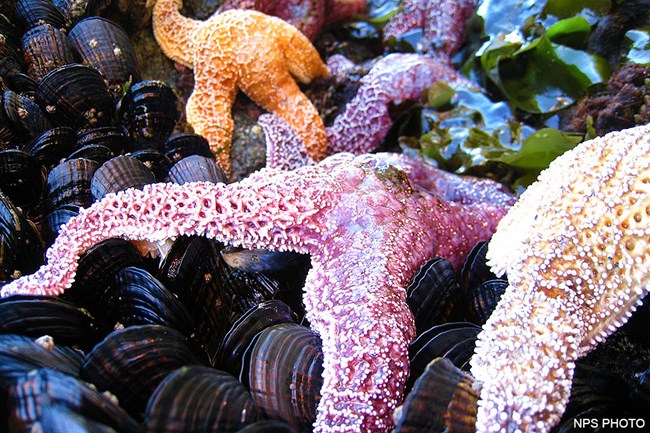|
Echinoderms are recognizable by their (usually five-point) radial symmetry, and include such well-known animals as sea stars (commonly called starfish), sea urchins, sand dollars, and sea cucumbers. The phylum Echinodermata contains about 7000 living species, twenty-one of which may be found in the intertidal zone at Point Reyes National Seashore. 
Sea StarsSea stars, a sturdy yet flexible predator, are the tigers of the intertidal zone. When a sea star finds a mussel that seems like it will make a sufficient lunch, it will use its thousands of tube feet to cling to the bivalves shell. Then it pulls. The sea star doesn't need to pull the shell very far apart, a crack will do. Once an opening has been created, the sea star does something extraordinary: it extrudes its stomach from its body. The sea star will actually push its own stomach into the opening it has made. Digestive processes then go to work, turning the mussel's flesh into a delicious slurry that the sea star's stomach can then absorb. Sea star wasting disease garnered media attention in late 2013 and early 2014. Sea star wasting disease is a general description of a set of symptoms that are found in sea stars. Typically, lesions appear in the ectoderm followed by decay of tissue surrounding the lesions, which leads to eventual fragmentation of the body and death. Scientists at UC Santa Cruz and partners are continuing to investigate a coast-wide die off of sea stars along the west coast of the US. There has been some evidence of wasting disease at Point Reyes this year and anecdotal declines in numbers of sea stars in some locations. However, it is unknown if these types of die-offs are relatively natural (there were similar events in 1983 and 1997) or how quickly populations can recover post-disease. For additional details, visit UC Santa Cruz's Sea Star Wasting Syndrome page. Sea UrchinsSea urchins are found in the lower intertidal zone in tide pools and are abundant in the subtidal zone. In some areas, large groups of urchins eat their way through kelp beds to create "urchin barrens" where seaweeds are scarce; then, the urchin population decreases because of lack of food, allowing the kelp beds to recover. In areas where sea otters are present, this cycle isn't as extreme. Sea urchins are a favored food of sea otters, and sea otters keep sea urchin populatioins in check. |
Last updated: September 19, 2022
